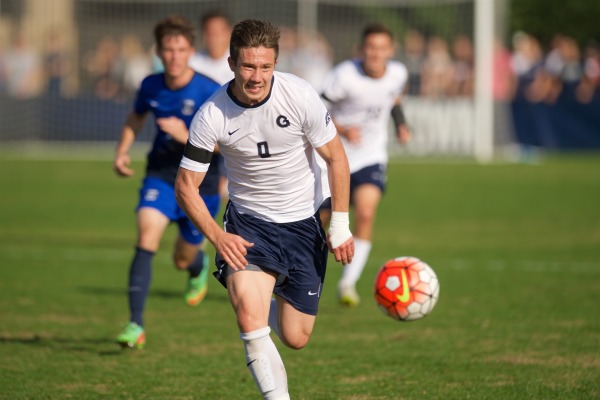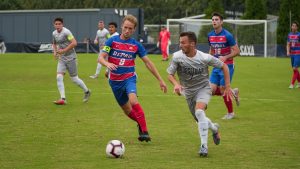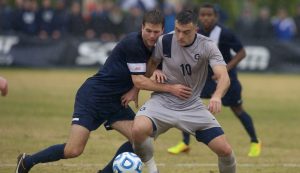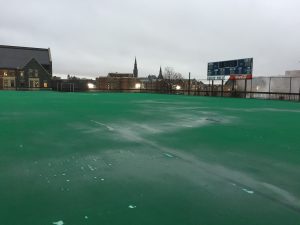In college sports, a few months is a lifetime.
In that time, someone can transform from a nobody to a contender, a frontrunner to a spectator, or a student to a professional. Logic doesn’t always function in college athletics. What should happen, rarely does. And what shouldn’t happen, often becomes reality.

Sports Information
The 2015 Georgetown men’s soccer season registered the longest undefeated and winning streaks in program history, Georgetown’s first ever Big East Tournament Championship, and the team sent a record-breaking six players to Major League Soccer. However, it also featured perhaps the most heartbreaking loss in recent memory and a premature exit from the NCAA Tournament.
Much can be said about the roller coaster season, but one thing is for certain: it didn’t make a whole lot of sense.
This is how a would-be mechanical engineer led an unlikely group of Hoyas to the most historic season in program history, and why it never should have happened.
The Coach
In 1995, Brian Wiese was an aspiring mechanical engineer. He had just graduated from Dartmouth College with a degree in Product Design, hung up his cleats after a brief stint as a goalkeeper with the Zimbabwean club Bulawayo Highlanders, and decided to move out to California and pursue his master’s at Stanford.
In his first year out of Dartmouth, Wiese worked as an engineer in San Diego, but sport of soccer wasn’t quite ready to let him go. One day, when Wiese left his apartment to go for a run, fate intervened, and he became the head coach of the Del Mar Tsunami Girl’s Under-17 team.
“They practiced at a park behind my apartment complex, and I was off on a run,” Wiese explained. “I stopped at the park to stretch and the team manager was standing there and we got into conversation, and next thing you know I’m coaching the team the next week.”
When Wiese arrived at Stanford, he was pulled back into soccer once again. The Stanford men’s soccer team had a vacancy at head coach, and Wiese’s former coach from Dartmouth, Bobby Clarke, took the position.
“He just so happened to be going to Stanford to take over the men’s program at the exact same time as I was going up there to enroll in my Master’s,” said Wiese.” “He was like ‘You know, I’d love to have you help.’ And I said, ‘That sounds like great fun. I’ll do that for free.’ It was one of those things where it probably didn’t help my Master’s Degree, but I had such a fun time coaching in those years.”
After completing his studies in 1998, Wiese did not leave Stanford. He stayed on for another three years as Assistant Coach, until 2001.
“The time came to pick what was I going to do,” said Wiese. “Was I going to try to get into something with product design? I didn’t have the opportunity to do both. I had to choose between one or the other, and it was a non-decision. I knew my heart was always to coach, and I love to coach. Unfortunately for my bank account, it probably wasn’t the best long term decision.”
When Clarke left for the head coaching position at Notre Dame in 2001, Wiese followed him as an assistant. In 2005, Wiese was promoted to Associate Head Coach.
In 2006, Wiese received a call from the Hilltop, and he never looked back.
“At the end of the day, I love getting up and driving to Georgetown every day,” said Wiese. “I can’t ask for anything more than that.”
Since taking his first, and only, head coaching position at Georgetown 10 years ago, Wiese has had many successes. He brought the Hoyas to their first NCAA Tournament since 1997, and made Georgetown history by leading the team five NCAA Tournament appearances in six years. In 2012, Wiese’s Hoyas streaked to the national championship game, where they fell in penalty kicks to the Indiana Hoosiers. In 2013, he was named the NSCAA Division I Coach of the Year.
Building a Program
From coaching a youth club team in San Diego to building one of the premier soccer programs in Division 1 athletics in the nation’s capital, Wiese’s focus over his time at Georgetown has been on recruiting the right players for the right system.
“I don’t think you recruit any of the players thinking, ‘well, this guy’s going to be a pro,’” Wiese said. “I think all the kids you recruit, you like for a reason, and they have traits that you really like, but there’s just so many things that have to happen, and there are so many variables, that you just don’t know what will end up happening.”
Though some of the most high profile prospects in club soccer receive a continual barrage of recruitment emails, phone calls from coaches and invitations to visit universities, Wiese’s vision for the future of Georgetown soccer didn’t include a star-studded roster of the most highly touted high school players in the country; instead, he hoped to find the right blend of personalities and players who were self-driven and confident on and off the pitch.
In the 2012 recruitment cycle, Wiese brought in three players—forward Brandon Allen, and defenders Cole Seiler and Keegan Rosenberry—who would make an instant impact as starters on Georgetown’s 2012 College Cup Runner-Up team. Defender Josh Turnley would become the team’s starting fullback in his sophomore year, and midfielders Melvin Snoh and David Witkoff would be key energy players coming off of Wiese’s bench over their four years with the Hoyas.
Rosenberry, who became one of the team’s most vocal leaders and crucial contributors, was not a highly-recruited high school superstar.
“He wasn’t overly fast,” Wiese explained. “And we’re sitting here with other coaches and they’re looking at us kinda scratching their heads and saying, ‘Well I don’t know if we like him that much, or as much as you guys,’ … A lot of coaches out there were like, ‘I don’t know if it’s worth us pursuing him.’”
Wiese and the Hoya coaching staff did pursue him, and it paid off for the team, as well as its future captain.
After the team was defeated in the 2012 College Cup final, Wiese and the Georgetown staff were able to bring in two of the most prized prospects in the nation going into 2013: forward Alex Muyl, who had been a part of the U.S. National Team Regency Program, and Ghanaian defender Joshua Yaro, whose athleticism and skill helped him thrive in West Africa’s Right to Dream program.
At the beginning of the 2013 season, Yaro found himself anchoring the Georgetown defense alongside Seiler, Rosenberry and Turnley. This Georgetown back line soon became one of the most successful in the country.
During their 2013 campaign, the Hoyas surrendered just eight goals in 21 games, and led the nation in shutout percentage (.607). In his freshman year, the scrappy Muyl was inserted into Wiese’s starting 11, where he began a three-year partnership with Allen up top, and quickly became the team’s primary playmaker. The attacking duo of Allen and Muyl registered 15 goals and 14 assists in 21 games on the season. The team finished at 14-5-2 on the year after dropping their Third Round matchup against the Michigan State Spartans.
With the same offensive and defensive core, the 2014 season was promising for Wiese’s Hoyas, who won 14 games for their second straight season before falling in penalty kicks to Virginia in the NCAA Quarterfinals.
Along the way, Yaro, a soft-spoken and dedicated student with aspirations for a future in diplomacy for his home country, broke out as the Big East Defensive Player of the Year, and one of college soccer’s most celebrated MLS prospects. After months of speculation, Yaro decided to pass up a surefire MLS SuperDraft selection to come back for another year at Georgetown.
With another season under their belts, Wiese named each member of his defensive tandem—Yaro, Rosenberry, Seiler and Turnley—captains for the 2015 season.
A Bumpy Start
Three games into the season, Georgetown had registered one tie, two losses, and zero goals scored. The team uncharacteristically struggled offensively, and the defense missed the presence of Yaro, who was injured during the team’s opening road trip.
Through three games, the Hoyas had drastically underperformed after being ranked the No. 3 team in the nation in the NSCAA Preseason Poll. To make matters worse, the Hoyas were carrying their slump into a meeting with the then-No. 1 team in the country, the UCLA Bruins, and Yaro was still unable to play. The Hoyas had already plummeted in the rankings to No. 25.
Yet somehow, some way, they won. The Hoyas upset the Bruins 3-1, notching the first three goals of the game, and most importantly, their first win of the season.
The Streak
“There was one of those things where you beat UCLA and the guys are saying ‘we don’t lose again this year,’” said Wiese.” “And I remember that vividly from the guys and I remember saying ‘Well wouldn’t that be nice,’ but they were right– they didn’t. They didn’t lose again.”
After a 5-2 rout of Radford and an overtime draw against VCU, Yaro returned to help the Hoyas to a 3-1 win over West Virginia. After the defender rejoined the lineup, the Hoyas won every remaining game in the preseason and Big East play.
Georgetown did not dominate most games during the streak, which included four overtime wins, and the Hoyas were not technically flashy. Instead, many of the wins were the result of hustle and grit.
As the leaves fell from the trees in the fall, so did the best competition that the Big East had to offer. Yaro’s return to the lineup brought the back line back to its previously dominant form, and the Georgetown offense was reignited after its slow start.
Through the veteran leadership of the Georgetown captains and the combination play between Muyl and Allen up top, Georgetown streaked to a perfect 9-0 in Big East play, including a win over the then-No. 2 Creighton Bluejays, a team projected not only as a Big East contender but a College Cup contender as well, before entering the Big East Tournament with the No.1 seed.
In the final game of the tournament, the Hoyas drew Creighton once again, providing the Bluejays an opportunity for revenge. The teams were deadlocked 1-1 after regulation, but in the 107th minute, Muyl struck a shot inside the far post and locked up Georgetown’s first ever Big East Tournament championship.
“To be the first team in history to do it is obviously going to cement our program and that year in the history books,” said Rosenberry. “I think with the type of closely-knit group we had, it means even more.”
“With the schedule we play,” added Wiese, “to go undefeated in the Big East 9-0, first time in program history we did that, win the Big East tournament, first time in program history we’ve done that, to realize those goals, and to do it the way we did it … that was really special.”
It had been 16 games since the loss to Akron, and the Hoyas had not lost one. The last 13 were all wins. Over those 16 games, Yaro, Rosenberry, and the rest of the Hoya defense allowed only 12 goals, including six straight shutouts. It was already the longest undefeated and winning streak in program history.
The stars seemed to be aligning for the Hoyas, whose senior core of Seiler, Rosenberry, Allen and Turnley had one final chance at an elusive College Cup. The Hoyas received the third overall seed, and were fully expected to make a deep run, if not go all the way. The Hoyas drew Hofstra in the second round of the NCAA Tournament after a first-round bye, and cruised past the Pride 3-0.
The Heartbreaker
By the time the lesser-known Boston College Eagles journeyed down to Washington for the third round of the tournament, the Hoyas boasted the best defense in the country, and were the hottest team in the tournament.
Once again, the Hoyas didn’t lose in regulation. Except this time, not losing in regulation wasn’t enough.
Rosenberry scored the Hoyas’ only goal in the contest, and after two overtime periods, both teams were still tied at one-apiece.
Rosenberry uncharacteristically missed the third Georgetown penalty kick, but the Eagles didn’t miss any, advancing 5-4 after the 1-1 draw.
In a little over two hours, the Hoyas’ streak had vanished and its season was finished.
“I’ll always have that little thing that’s nagging at us, I wish we had gone further in the NCAA tournament. I feel that it was really a special team,” said Wiese. “If there’s ever a team that could have won the whole thing, that I’ve ever been around, it was last year’s group for sure.”
Despite their early exit, the Hoyas extended their “undefeated” streak to 18, a streak that, according to Wiese, is technically still alive because the game was decided by penalty kicks. But just as much as the 2015 season will be remembered by the streak, it will always be marred by the disappointment of the early tournament exit. The 2015 campaign featured upsets and thrilling overtime victories. But in one of the few games the Hoyas were expected to win, the most important game of the season, they slipped.
The Draft
Within the month after the Hoyas had their College Cup hopes spoiled by Boston College, the dominos began to fall.
Allen was the first of the Hoyas to sign a professional contract when the New York Red Bulls announced that he’d be joining the club as a Homegrown Player. The next day, the club announced that Muyl had decided to forego his last year of eligibility in favor of joining Allen and the Red Bulls as well. The Hoya attacking partners will stay intact, at least for the time being.
Three weeks later, when most Georgetown students returned to the Hilltop to begin another semester, the 2016 MLS Superdraft held the hopes and dreams of several Georgetown athletes in the balance. With the second pick of the draft, the Philadelphia Union traded up to select Yaro, the Big East Defensive Player of the Year yet again, who, a week earlier, was announced as a member of the 2016 Generation Adidas class.
“Georgetown as an institution challenges us in the classroom and on the field,” said Yaro. “I think that those challenges helped me as a person to really know my strengths and weaknesses and help me to work to overcome every obstacle that comes my way. My time at Georgetown has contributed to that a lot and has built me and prepared me for my next step.”
Philadelphia had the third pick as well, and selected Yaro’s backline partner Rosenberry—a Pennsylvania native who had grown up playing within the Union academy.
Just like Allen and Muyl, Yaro and Rosenberry will continue to play alongside one another at the next level, an opportunity that neither of them take lightly.
“I think the media does a great job of capturing how good of a player [Yaro] is and what kind of a talent he has,” said Rosenberry. “But sometimes what isn’t captured is just what type of kid he is. Not to say the media does a bad job or anything like that but, he’s such a good kid, he’s got a great heart, and he works his butt off whether he’s on the field or in the classroom.”
“We’ve known each other for a long time, not only as players, but as humans and as friends,” added Yaro. “We’ve grown to really getting along well. I’m really looking forward to my time with him playing on the same team.”
Seiler was the next Hoya defender taken off the draft board, when Vancouver Whitecaps FC selected him with the 16th pick overall. Turnley was the last to go, taken five days later in the third round of the draft by the LA Galaxy.
With Turnley’s selection, all four Hoya starting defenders became professionals. The six Hoyas to turn pro broke the Georgetown school record, as did Yaro individually as the university’s highest ever pick.
“Six of those players walking out the door is something that just doesn’t happen very often on any team around the country,” said Wiese. “You know how hard they worked to get to Georgetown, and you know how hard they worked while they were at Georgetown, with the hope of this kind of opportunity. And the fact that I think all six are really wanted at the places they were taken is exciting, and we’re hopeful that it’s the start of a long career for each of them.”
“I think you have to look at the coaching staff, and I certainly credit them,” added Rosenberry. “The type of guys and the type of group they’re able to put together year-in year-out, certainly over my four years, it’s very rare that you find a similar type of kid that wants to play for the same program across the whole country. We have a pretty unique environment and unique culture and guys want to get better and they want to be pros.”
Looking Ahead
Within this calendar year, six former Hoyas from the 2015 squad will have the opportunity to take the field with some of the most renowned stars in international soccer: David Villa, Andrea Pirlo, Kaká. While the six former Hoyas were playing in front of 3,000 fans Shaw Field only three months ago, they’ll soon be featured at Yankee Stadium, Talen Energy Stadium, and the StubHub Center.
If anything, the 2015 season—the most historic season in the history of Georgetown soccer—was improbable. Brian Wiese could have become an engineer and never decided to coach. Keegan Rosenberry might never have become a Hoya. The team never should have beaten UCLA without Yaro, and they shouldn’t have beaten Creighton with him. In the end, most believed they would advance past Boston College.
Entering the 2016 season, the Hoyas will be without six of their starting 11, including the entire back line. Though the Georgetown reserves have plenty of practice experience against MLS talent, practice is one thing, and the College Cup is another.
“We’ve got a lot of work to do,” said an optimistic Wiese. “This is where we’ll earn our coaching badges. Its an interesting time because there is such a big turnover all at once, but there’s kids that are going to get their opportunities now. I think that’s the fun of being a college coach.”
Wiese and his coaching staff now only have six months to replace the best core in program history.
If this season has taught them anything, however, it’s this: six months may not seem like nearly enough time to rebuild a championship-contending team, but six months is plenty of time for even the unimaginable to materialize.




